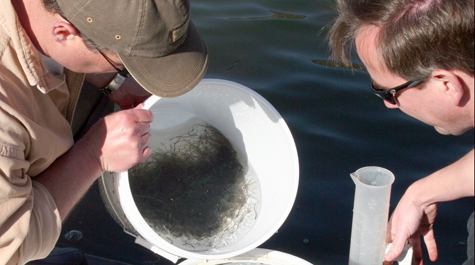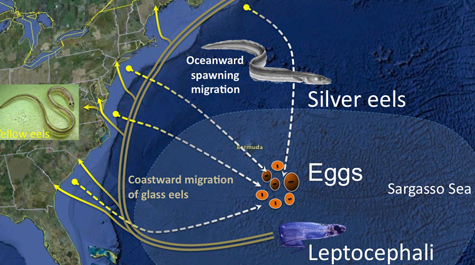VIMS researchers monitor status of American Eel
Like the animals they seek, members of the VIMS' American Eel Monitoring team spend a lot of spring days struggling through muck and climbing over obstacles. Their quest is to count the young eels now migrating into Virginia's estuaries and freshwater tributaries.
Members of the team have been monitoring the spring migration of juvenile eels since 2000, partnering with fisheries teams in other East Coast states to provide the first comprehensive picture of the eels’ coast-wide population. Understanding the size and dynamics of the species’ population is key to its effective management and protection.
The VIMS eel survey is in response to a 1999 mandate from the Atlantic States Marine Fisheries Commission (ASMFC) to monitor the “recruitment” of juvenile eels from the ocean into estuaries. Recruitment refers to the movement of eels hatched during the previous year into coastal waters to join the resident population. The ASMFC mandate was motivated by sharp drops in commercial eel landings beginning in the 1970s.
The decline of American eels is also evident in data collected by the VIMS Juvenile Fish Survey. The survey, which has been recording the abundance of young fishes in Virginia's waters since 1955, recorded a 3-fold decline in eel abundance in Chesapeake Bay between the mid-1980s and mid-1990s.
Troy Tuckey, head of the eel monitoring team at VIMS, says a number of factors could be contributing to the eels’ decline, including “dams, fishing pressure, and infection by a parasite.” The decline is so severe that in 2006 the U.S. Fish and Wildlife Service considered the eel—once a staple of local cuisine—for protection under the Endangered Species Act.
But comprehensive data on the coast-wide population of American eels and their year-to-year recruitment success remains limited, largely due to the complexity of the species’ life cycle. The eels are catadromous—with “yellow” eels spending from 8 to 25 years in inland waters before maturing into “silver” eels that migrate to spawn in the open ocean south of Bermuda. The spawn—nearly transparent, ribbon-like larvae known as leptocephali—travel the Gulf Stream to the east coast of North America, transforming into “glass eels” and then “elvers” as they swim up coastal tributaries from Florida to Newfoundland. The trip from the open ocean to coastal waters takes from 9 to 12 months.
It is these “young-of-the-year” juveniles that are sampled by the VIMS team—at sites on the James, York, Rappahannock, and Potomac rivers—and by the other eel-monitoring teams in rivers along the Atlantic seaboard.
Only now, after nearly 10 years of sampling, are these teams closing in on the long-term and geographically spaced records needed to gauge the eels’ coast-wide population. These types of records are needed to detect any trends from within a dataset that shows large shifts from year-to-year and place-to-place in the number of young eels and the timing of their spring run.
“We’re just getting to the point where we have enough data to understand recruitment variability,” says Tuckey. Their data suggest that ups and downs in recruitment might be due to eels jumping off the Gulf Stream at different points along the coast in different years. “There might be a ‘flip flop’,” says Tuckey, “in which declines in our glass eel numbers one year are offset by increases in the number of glass eels migrating into New England, and vice versa.”
Shifts in coastal currents such as the Gulf Stream are thus one factor that bears additional study, says Tuckey. Other factors that might affect the size and timing of the spring run include river flow and water temperature within tributaries, wind patterns, and tidal cycles. The VIMS study shows the eels delay their migration until waters warm and flow decreases sufficiently for them to move upstream. In cold and wet years like this one, their springtime migration can be delayed by several weeks.

















